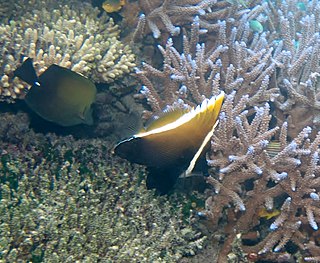
Marine angelfish are perciform fish of the family Pomacanthidae. They are found on shallow reefs in the tropical Atlantic, Indian, and mostly western Pacific Oceans. The family contains seven genera and about 86 species. They should not be confused with the freshwater angelfish, tropical cichlids of the Amazon Basin.

Combtooth blennies are blenniiformids; percomorph marine fish of the family Blenniidae, part of the order Blenniiformes. They are the largest family of blennies with around 401 known species in 58 generas. Combtooth blennies are found in tropical and subtropical waters in the Atlantic, Pacific and Indian Oceans; some species are also found in brackish and even freshwater environments.

Labrisomids are small blennioids (blennies), percomorph marine fish belonging to the family Labrisomidae. Found mostly in the tropical Atlantic and Pacific Ocean, the family contains about 110 species in 15 genera.

The blennioid family Chaenopsidae includes the pike-blennies, tube-blennies, and flagblennies, all percomorph marine fish in the order Blenniiformes. The family is strictly tropical, ranging from North to South America. Members are also present in waters off Japan, Taiwan and Korea. Fourteen genera and 90 species are represented, the largest being the sarcastic fringehead, Neoclinus blanchardi, at 30 cm (12 in) in length; most are much smaller, and the group includes perhaps the smallest of all vertebrates, Acanthemblemaria paula, measuring just 1.3 cm (0.51 in) long as an adult.

The striated frogfish or hairy frogfish is a marine fish belonging to the family Antennariidae.

The spinyhead blenny is a species of blenny native to the tropical western Atlantic Ocean and Caribbean Sea.

The queen angelfish, also known as the blue angelfish, golden angelfish or yellow angelfish, is species of marine ray-finned fish, a marine angelfish belonging to the family Pomacanthidae. It is commonly found near reefs in the warmer sections of the western Atlantic Ocean.

Stegastes variabilis is a damselfish in the family Pomacentridae, found on coral and rocky reefs in the Caribbean Sea and neighboring areas of the Atlantic Ocean and Gulf of Mexico. They are often solitary fish.

Coastal fish, also called inshore fish or neritic fish, inhabit the sea between the shoreline and the edge of the continental shelf. Since the continental shelf is usually less than 200 metres (660 ft) deep, it follows that pelagic coastal fish are generally epipelagic fish, inhabiting the sunlit epipelagic zone. Coastal fish can be contrasted with oceanic fish or offshore fish, which inhabit the deep seas beyond the continental shelves.

The Australian blenny is a small marine blennioid fish of the genus Ecsenius. They are small and reddish brown with a white ventral side. Australian blennies inhabit the shallow marine waters of the tropics. They are often found along the Great Barrier Reef and Coral Sea of Australia.

The seaweed blenny is a species of combtooth blenny found in coral reefs in the western Atlantic Ocean along the coasts of New York, Bermuda, the Bahamas, also in the Gulf of Mexico, south to southern Brazil. This species reaches a length of 8.5 centimetres (3.3 in) TL.
Gobioclinus gobio is a strictly marine ray finned fish, also called Gobioclinus gobio. Its common name is the palehead blenny, and is sometimes referred to as the goggle-eye blenny. It can be identified by its greenish top, red belly, and multicolored banding. L. gobio is a benthic organism with a wide range, taking up residence in a number of coastal environments from Florida to Brazil. This means the fish can live in equatorial, subtropical, and tropical climatic zones. It is native to coastal areas of the Caribbean. Its diet consists mainly of different molluscs and echinoderms.
Paraclinus fasciatus, the banded blenny, is a species of labrisomid blenny native to the Atlantic Ocean including the Gulf of Mexico and the Caribbean Sea from southern Florida to Venezuela. The banded blenny is a marine organism, meaning it lives in an aquatic environment. This species lives in the vicinity of coral reefs preferring sea grass beds in shallow waters down to 2 metres (6.6 ft). Although they are typically located in shallow waters, their colors camouflage them exceptionally well, leading to them rarely being seen or recognized. They have also been found within floating algae.
Paraclinus marmoratus, the Marbled blenny, is a species of labrisomid blenny native to the western Atlantic Ocean including the Gulf of Mexico and the Caribbean Sea from southern Florida to Venezuela. This species can be found in shallow waters down to a depth of about 6 metres (20 ft) on coral reefs and in sea grass beds. It seems to show a particular association with the sponge Verongia fistularis. This species can reach a length of 10 centimetres (3.9 in) TL. It can also be found in the aquarium trade.

Stegastes fuscus, the dusky damselfish, is a species of bony fish in the family Pomacentridae found near the seabed in shallow waters on the western fringes of the Atlantic Ocean.

Chaetodon guentheri, Günther's butterflyfish or the crochet butterflyfish, is a species of marine ray-finned fish, a butterflyfish belonging to the family Chaetodontidae. It is native to The western Pacific Ocean.

The orangespotted filefish is a species of filefish described by Ranzani in 1842. and it is native to shallow waters in the tropical and subtropical Atlantic Ocean, the Caribbean Sea and the Gulf of Mexico.

Heniochus pleurotaenia, the phantom bannerfish, is a marine fish belonging to the family Chaetodontidae, native from the central Indo-Pacific area.

Heniochus varius, the horned bannerfish or humphead bannerfish, is a species of marine ray-finned fish, a butterflyfish belonging to the family Chaetodontidae, native from the central Indo-Pacific area.

Astrapogon stellatus is a species of ray-finned fish in the family Apogonidae, the cardinal fishes. It lives in the tropical western Atlantic Ocean, the Caribbean Sea and the Gulf of Mexico. It is commonly known as the conchfish because it typically conceals itself in the mantle cavity of a living queen conch by day.



















